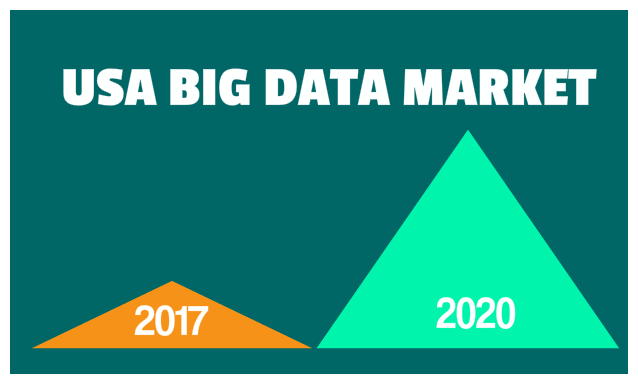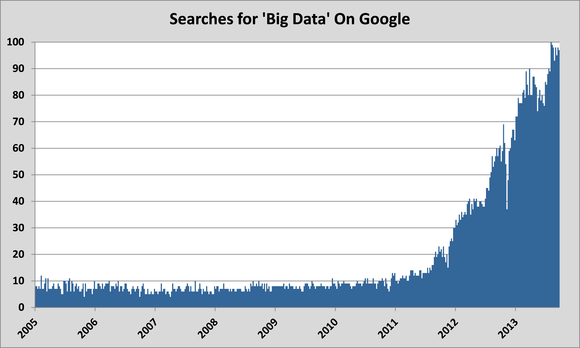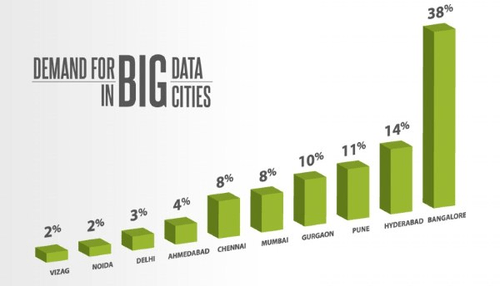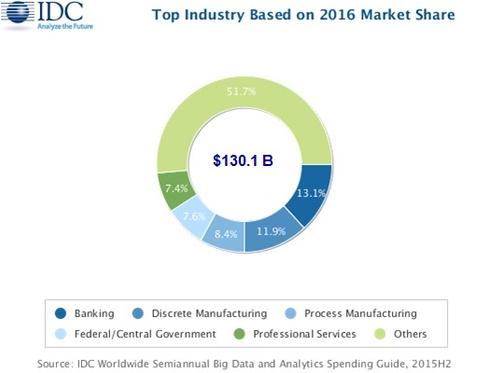
Future of Big Data: Trends Shaping Tomorrow’s Busines
The Big Data phenomenon has taken the corporate world by a storm. Business divisions and large companies are excited about the prospects of introducing Big Data in various functional aspects of the organizations. One could argue that talking about the future of Big Data is beside the point since it is already here. However, as a business concept, it is still to reach the small and medium-sized businesses. There are two most crucial certainties that could be predicted for Big Data: first of, it will be nothing like the yesterday’s infrastructure meant for data management, and secondly, it will grow at rapid pace. In this article, some of the most crucial aspects have been taken into account. The relevance and popularity of the concept have already increased. Let’s consider the following chart:

The above chart is an indication of a constant increase in the interest of users in the concept. The overall number of searches has increased even further in the present scenario when the concept has become a known force to reckon.
Will the data volumes continue to grow?
There is no doubt that data will continue to grow at an unprecedented rate in the future. The internet speed has been improving and even the emerging countries now have the access to high-speed internet based devices. Due to computers and handheld devices, the overall data is expected to grow exponentially in the future as well. Social media and increased business operations are expected to grow at rapid pace, thereby resulting in constant growth of the available data. The Big Data workloads will be shifted to the cloud. A major part of the analysis shall be deployed in the cloud-based servers, thereby reaffirming the importance of cloud computing in the data assessment industry. Even if the data growth continues to what it is today, the volume of data produced across the world could be way beyond imagination.
How would the analysis part be improved?
Even though SQL will be the prime standard in data analysis in the future, the importance of Spark will also increase as a data analysis tool. In the recent past, Microsoft and Salesforce had announced various new features which will help the non-coders to create new applications which will let them in viewing the business data. It is also accepted that by the year 2020, most of the business analytics software will have prescriptive analysis for better data assessment and analysis.
What shall be the impact on prescriptive analytics, artificial intelligence, and machine learning?
Prescriptive analytics is the final phase of business analytics process. In the current stage, most businesses are dependent on the first phase of business analytics which is known as descriptive analytics which is based on the historical data. Machine learning and artificial intelligence will be crucial elements in preparation of prescriptive analysis which will, in turn, help the businesses in moving ahead of the competitors. The machines are expected to take over business intelligence and data analytics.
What will be the trends in the job market?
There will be a number of new and high paying jobs in the field. The new business fields will include data-as-a-service. Since the concept is new and there is no formal field of academics dedicated to it, there will be a crunch of experts working in the field.

The professionals having exposure to Big Data will land up better and high paying job alternatives. The companies will have new positions like Chief Data Officer. The overall amount of employment opportunities is expected to increase in the next few years. The trend in the job market of Indian cities for Hadoop and Big Data professionals is expected to swell in the future.
What about the privacy and security violations?
With the increased popularity of Big Data, there would be many issues related to privacy and security violations. With a number of new privacy regulations in place, it is estimated that by the end of the year 2018, around half of the business ethics related issues will be related to data.
Besides this, Big Data is expected to impact various other industries apart from the traditional businesses. Considering the chart on the right, the substantial industry will be based on other sectors besides banking, manufacturing, government sector, and professional services. It is an indication of the fact that small and medium-sized companies have a crucial role to play in the development of Big Data.

The concept is still in the evolutionary stages. However, by the end of the year 2020, the concept is expected to cross the limit of $200 billion worldwide. The number of companies investing in Big Data is expected to increase even further. The overall amount of challenges in the field is also expected to increase even further. However, the managers should consider taking a more holistic approach towards the phenomenon and must try to integrate it with the business objectives. In the next few years, the businesses around the world are expected to invest a fair amount of money in the process. However, it will be rather difficult to measure the return on total investment in the next 5-10 years of operation.
The small and medium-sized businesses would be the last to adopt Big Data processes due to capital constraints. However, business leadership will help in the transformation of the small and medium sized business’s mentality, and adoption of Big Data processes shall be swifter. Big Data should not be considered as a separate effort in regards to the businesses adopting it. It should rather be considered as an essential part of the business dynamics like the internet which is crucial for the survival of the business in the future.
